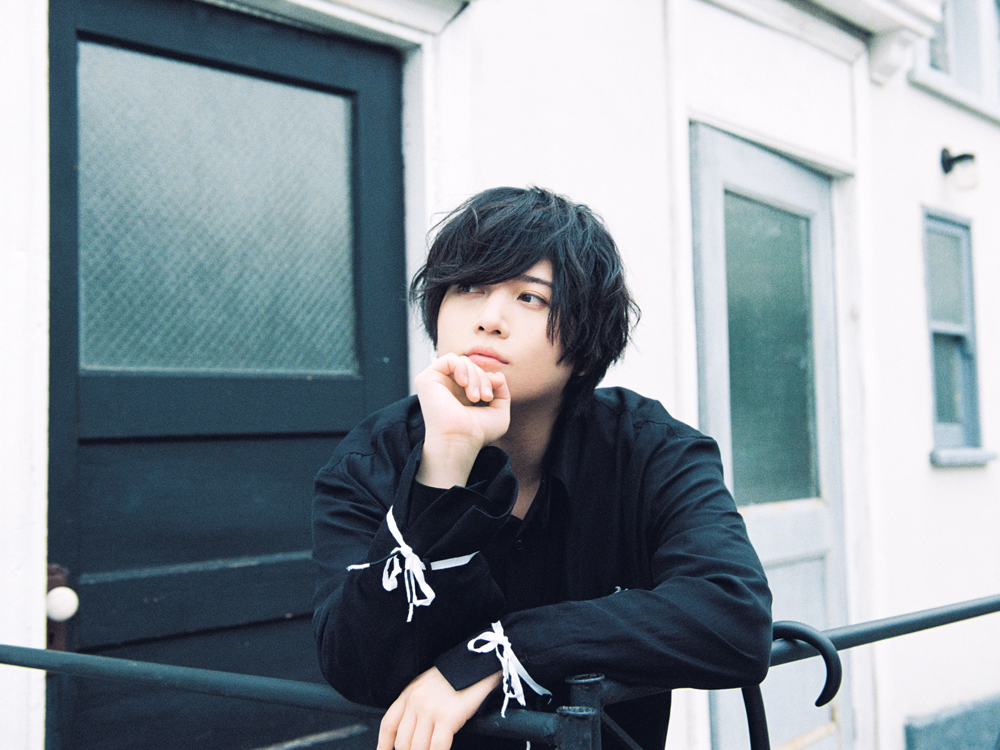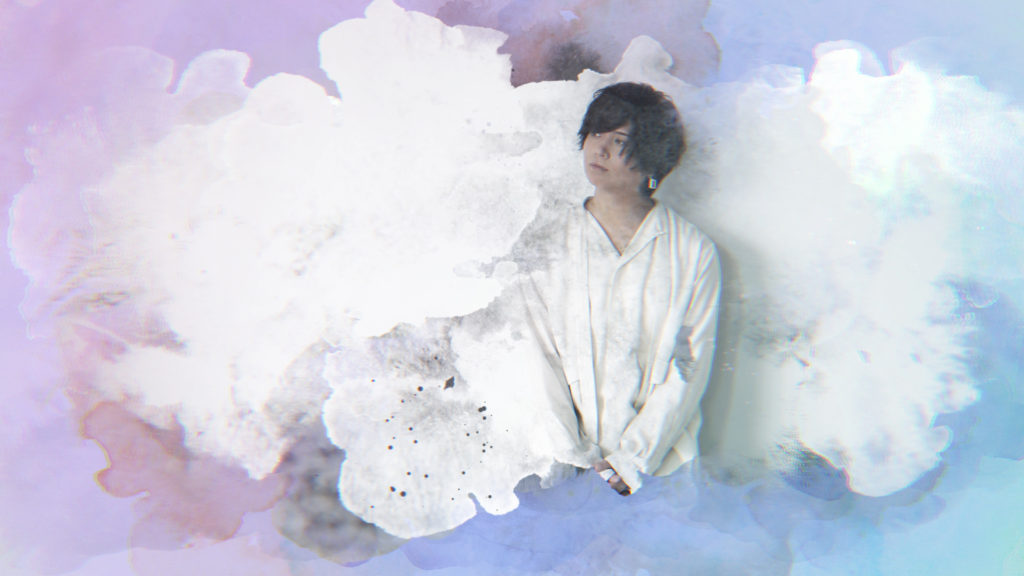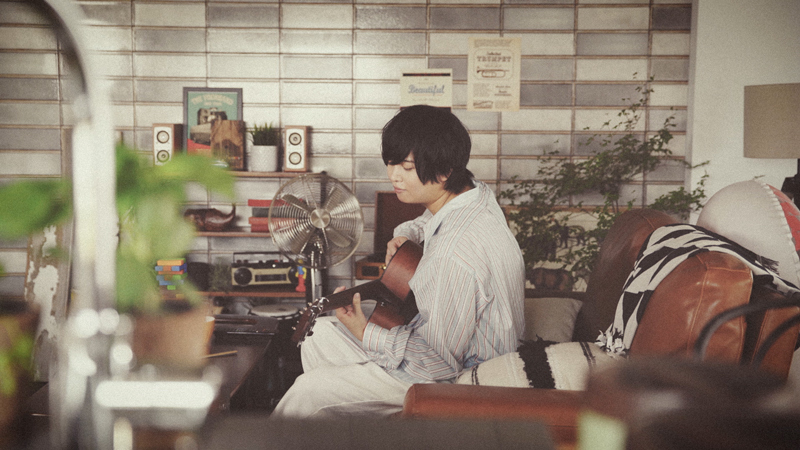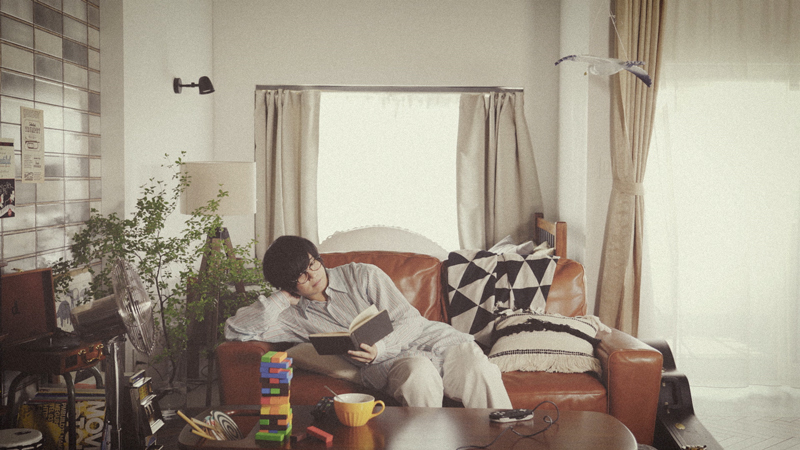
Published: 2020/8/27
Original URL: https://spice.eplus.jp/articles/274703
Saito Soma has started his “in bloom” series, which marks the second chapter of his artist career. The three digital singles with the themes “changing of seasons” and “after the end of the world” are currently in the process of being released. Following the first single “Petrichor,” the second single “Summerholic!” was released on August 19th, and the third single “Palette” is coming out on September 19th. We interviewed Saito about the “in bloom” series and his thoughts about the three songs, and he said “When I created these three songs, I could tell that I’d be writing more songs like these in the future.” We’re highly anticipating the second chapter and what kind of expressions he’ll entertain us with now that he’s unleashed himself.
Q: What thoughts did the artist Saito Soma put into Chapter 2?
There wasn’t anything too definite at first, but I started with the intent of writing songs that would yet again be different from what I’ve released so far. The mini-album I released in December 2019, my blue vacation, was entirely themed around “traveling” and “the end of the world,” and it felt satisfying when it went well. That being the case, I decided in my heart that I would start expressing the musical styles and compositions that I’d been “restricting” up until now. It was the fans that made me think that way—many of them wrote letters to me saying, “Even if you do deeper music, I’ll still listen to it.” Up until then, I’d been restricting myself, thinking “This song would be too dark for the voice actor Saito Soma to sing” or “A song sung by the voice actor Saito Soma needs to have some degree of entertainment, so I’ll give up on this one.” But going forward, I think it’ll be okay to clear away those thoughts.
Q: How did you feel about the requests for deeper music?
I was genuinely thankful. None of my songs are so-called “message songs,” whether they were written by me or someone else. My songs aren’t about things I want to say–for example, my first single “Fish Story” is simply the story titled “Fish Story.” It doesn’t have anything to do with my own feelings. Since each and every one of my songs so far has a story to it, it’s not so much that I wanted people to accept the deeper parts of myself, but rather that it seemed like they’d accept music that was less pop-style, so I felt it’d be safe to try that. These three songs are an example of that, but I think my future releases will have even deeper elements. So, these three songs are still a bit more on “this” side.
Q: Up until now you’ve been releasing your conceptual works as CDs, but are there any benefits that you can only get from digital releases?
The advantage of being able to release one song at a time is that I can release songs that align with the real seasons. For example, if I’m releasing an album in December, it’s hard to include summer songs. I feel that this is a major strength, and I’m glad that the listeners felt the “currentness” of the song.

Q: The first song in the series, “Petrichor” (released June 27) was extremely fitting for the rainy season.
Since this June was going to be the third anniversary since my debut, I wanted to release a single at that time. However, due to various circumstances, it had to be a digital release. “Petrichor” already existed by then, and I really wanted to release it in June to coincide with the rainy season. And if I was going to do that, then the second song would be released in summer and the third song would be in the transition between summer and fall. In that case, it would be interesting to sing about the changing of seasons between June and September. That’s how I came up with the theme for these three songs.
The “in bloom” songs are very individual and introspective
Q: The second song, “Summerholic!” (released August 19) is extremely fitting for summer, but when you pay attention to the lyrics, it’s a surprisingly peculiar summer song.
“Petrichor” is the type of song that grows on you as you listen to it over and over, so for the second song, I wanted to do the reverse—an upbeat song that you can get right into, that feels like summer. “Summerholic!” was the result of that. But, everyone has their own ways of enjoying summer. Just like the protagonist of “Summerholic!”, I like to think “The weather’s really nice today” and then proceed to stay in my room watching movies, drinking, and reading books. That’s one of my personal indulgent ways of spending time during the summer *laughs*. But that probably doesn’t quite align with the average person’s way of thinking. Normally, they’d think “It’s sunny, so why won’t you go outside?” but for me, I’m completely satisfied with this positive, luxurious way of enjoying the summer. So you could say that this song is twisted in an honest way. When I wrote it, I thought that that might be an interesting aspect of it.
Q: So it’s full of your personal ways of enjoying summer.
When I watched the MV from an objective point of view, I thought “He looks like he’s having a lot of fun, but he’s all alone in that room, huh…” and I didn’t know if it was funny or scary *laughs*. I’ve written songs like that before, but the three “in bloom” songs in particular are all immersed in their own worlds. So, the songs’ protagonists are really enjoying themselves, but someone watching from an outside perspective might think they’re suspicious. For example, “memento” (from my blue vacation) was a direct interpretation of “the end of the world.” But that wasn’t in the sense of a “personal” world, but “this entire world.” Compared to that, the “in bloom” songs are very individual and introspective. When I created these three songs, I could tell that I’d be writing more songs like these in the future.
Q: Even though the world views are becoming more introspective, the songs are upbeat with interesting compositions.
It’s important for music to be upbeat and fun to listen to, so I kept that in mind for all three songs. Also, the songs were intentionally structured to make you wonder “What do you call this part of the song?” J-pop often follows the A-Melody → B-Melody → Chorus structure, but that doesn’t mean it has to be that way. Thinking about it from another angle, a lot of the songs that I like don’t follow that template. In “Summerholic!”, the chords themselves don’t change much; it’s the same set looping over and over. But by changing the melody on top of them, they sound completely different, which is interesting, right? It’s a Western concept that I tried using.
Q: What variations can you introduce that way?
For example, the traditional A-Melody → B-Melody → Chorus structure has a sense of security to it, because when you listen to it, you’re prepared, like “oh, the chorus is coming next.” But when you listen to songs with changing structures, it’s exciting because you don’t know what’ll come next. Both are valid ways to compose music, but personally, I like it more when a single song can surprise me with how many twists it has, so I prioritized that excitement. This is one of my tastes.

Q: The intro phrase had a really good flavour to it.
I played the intro guitar phrase on loop in the DAW software while looking for chord progressions that would go well with it, and finished the song without a hitch. This chord progression is made up of seventh chords, which come from classical English music. It has a band aesthetic and just the right “dusk” feeling. It’s fun but has a hint of loneliness, which I think is perfect for this song.
Q: It was intriguing how the feeling of loneliness instantly went up just by adding a harmonica to the same melody.
The harmonica comes in at a good time, right? That was the arranger, Saku-san’s suggestion. But when I think about it calmly, I suddenly realize, “Is this person playing the harmonica in his room by himself…?” *laughs* This song has that kind of off-beat feeling… a “feigning ignorance” kind of humour. Those who thought it was a summery, happy song should try listening to it again with this perspective. I think you’ll enjoy the different impression it gives off.
Q: On that note, it’s also strange that there’s so many people shouting “Cheers!” with him even though he’s supposed to be alone in his room.
When I listened to the completed song, I went, “Wait, who is he shouting ‘Cheers!’ with?” *laughs* Naturally, the creator Saito Soma has his own idea of the song, but it’s also fun to interpret the song from a third person point of view as the listener Saito Soma. Also, if I can sing this song at a concert one day, I’m sure the call & response for that part will be fun.
Watching a movie at night… Saito Soma’s summer anecdote
Q: What was your interpretation, by the way?
There are actually hints in the lyrics. At the beginning of the vocals, it goes “yuurei datte hashaijaisou dayo ne” (even the ghosts are making merry), and in the latter half, he’s going “Cheers!” with people, which means…?
Q: Oh, that’s scary. *laughs*
Indeed. Well, it’s summer after all! It’s a song that’s fun to listen to while also having room for speculation.
Q: Is “Summerholic!” your ideal way of spending summer?
When I was little, I often did summer-like things such as going to the mountain or catching bugs. But I was always more of the indoor type, so I never really did the stereotypical, “It’s summer, so let’s go to the beach!” thing. However, I think summer is the most emotional season. Fireworks, watermelons, wind chimes, pools… Out of all four seasons, summer is the one with the most things that remind me of it.

Q: Do you have a summer fright story?
The other day, I was watching a movie at night. I was really engrossed in it, but suddenly I realized that something was going bang, bang, hitting my window. I looked outside and nothing was there, so I went back to watching the movie, but the banging sound was still there. Naturally, I went “Really…?” and fearfully opened the window. There was a cicada on the balcony *laughs*. It appeared that it got lost in there and couldn’t get out because it was fenced in. I knew I had to set it free somehow, so I grabbed my quickle wiper ((it’s like a Swiffer)) and scooped it up like I was playing cricket *laughs*. It was scary.
The theme of “Palette” is “the colours of emotions”
Q: On September 19, the third song “Palette” will be released.
I made this song when I was writing “Petrichor.” What I always do first is make a demo for the staff to listen to, about 90 seconds long, and if they like it, I’ll work on the full version. When I was doing that, I got stuck on the lyrics for “Petrichor” and wanted to take a break.
“Petrichor” is a song that builds groove using a refrain, so I found myself wanting to play the reverse: powerful, distortion-heavy phrases. I thought something like American emo music would be good, so I played some riffs and ended up easily finishing the first verse or so of “Palette.”
Music-wise, “Palette” has a quite direct sound. I was originally also thinking of releasing it after “Petrichor,” because an emotional song would be good for summer. But then this and that happened, “Summerholic!” was created, and I decided to sing “Palette” as an emotional band song representing the transition from summer to fall. So, the creation time was rather short, and I spent more time on the lyrics instead. The arranger Saku-san also spent a long time on “Petrichor,” but for “Palette” he said, “But this one was done instantly!” I think that’s probably because “Palette” is packed with elements that we band kids love.
Q: It sounds like something you’d want to hear at an outdoor concert at the end of summer.
With an explosive sound, right? I think it’s a striking song for both the performers and the listeners.
Q: What did you focus on with the lyrics?
For this song, as the title “Palette” implies, I wanted to sing about the “colours of emotions.” For example, during the time between summer and fall, you can feel both seasons, but there isn’t a precise name for that period. Similarly, there isn’t a name for transforming emotions. Rather than giving that scene a name, I wanted to express it through music and song, and I wrote the lyrics as such.
The lyrics are straightforward, so it should be relatively easy to understand. The last chorus also ends in a way that’s somewhat hopeful. Originally, the lyrics were a bit more destructive. Instead of the word “melt,” I had “break.” But, I settled on music and lyrics that leave a refreshing, positive aftertaste instead.
Q: It’s rare for a song of yours to have straightforward lyrics.
Directness is a virtue, and I think it’s important to be able to be direct and sing directly. But personally, I’d have to say that it’s embarrassing for me, so I prefer to deliberately distort, hide, and use humour to deceive. But rather than what I want to do, I prioritize what kind of lyrics the song needs. I felt that “Palette” called for direct lyrics, and personally I think I did a good job.
Q: The straightforward lyrics are a great match for the song’s noisiness.
When I made the demo, I requested that they make it loud and distort all of the sound. The orchestra is concentrated in the low notes, so I put the vocals in the medium to high range, and for the harmony, only the upper harmony was recorded. Since the powerful notes are in the low range, it’s a song where the vocals escape into the high range. It’s a good match for the opening lyrics that have the words “rooftop” and “return.”
Q: It’s a Saito Soma song that’s also brimming with band energy.
I try to leave as much to the participating musicians as I can. “Petrichor” is a song that values subtraction, and they brought out a wonderful groove with that. On the other hand, “Summerholic!” and “Palette” have something that only a live band can bring out. They’re different types of songs, but they both showcase how amazing and entertaining bands are, and I feel that the performers made the songs even more wonderful.
For Chapter 2 onwards, I’m freeing myself from the rules
Q: What style of music do you want to pursue after this?
What I like about music is imperfections. For example, if the pitch doesn’t match, or the rhythm is a bit too fast. I actually think that those aspects have an unparalleled appeal, and that’s what’s interesting about pop music. So, moving forward, I want to continue working with a variety of people.
The good thing about making music as an individual is that I don’t have to put restrictions on my musical style. I don’t have to say “The artist Saito Soma will absolutely only sing this genre.” I’m extremely grateful that I can change my way of singing or even my vocalization to suit the song. That’s exactly why I want to try forming bands with different musicians and pursue the grooves born from those combinations. The one thing is that I think the band style will always be at the heart of my music, because that’s what I mainly grew up listening to.
Aside from that, I’m also interested in more introspective music; the kind that I could even do the arrangement and mixing for by myself. Especially something that doesn’t even have a chorus…like acid folk and electronica. I don’t know if I’d actually do that under the name Saito Soma, though. I realized that I’d been putting restrictions on my music up until Chapter 1.5, so I’d like to free myself from those rules and release even better songs.
Q: I’m looking forward to hearing songs that are even more uninhibited than these three.
I’m still working on new songs right now, and I think I’ll be able to release something that goes in a different direction from anything I’ve done so far. There’s also a song that’s so completely different that if you ask, “Is this Saito Soma?” the answer is well, I think you’ll understand, maybe? *laughs* If I were to liken it to something… It’s like the result of cooking with the mindset from “Date.” The temporary name of the song is “Kitchen,” so please look forward to it. After creating “Petrichor,” “Summerholic!”, and “Palette,” I wanted to stray even further from the rules, so the plan is to spread out farther and farther from here on out.
What the fans’ analyses made me realize
Q: On the other hand, what do you think is the axis of your music, that will always be there no matter what surprises you bring?
I think it’d be pop. No matter what kind of difficult or high-level songs I do, it’s important that they’re enjoyable to listen to, so I don’t want to stray from that. I do think I’m going to be releasing more experimental songs, but that doesn’t mean all of the songs on an album would take that route. I want to maintain a balance between experimental songs and familiar pop songs. I hope that as a result, when you listen through an album, you’ll be able to enjoy both sides.
I do think that there’s a clear axis for which you could say “This is Saito Soma’s music.” But I think I’d like it if it were more, “There is, but there isn’t.” In Buddhism, there’s a doctrine called anatman, or “non-self.” It means that while people do have something like a “true nature,” it’s constantly in flux and can’t be defined concretely. For example, sometimes I’m cool and collected, but sometimes I’m impassioned, so you can’t say with confidence that “Saito Soma’s true nature is calm and collected.” But, my true nature does exist. After reading about it, it made sense to me. So, it might be ideal to use different presentations depending on the song.
Ultimately, I think I’d be happy if people said “I couldn’t tell that it was Saito Soma’s song.” I say this about voice acting too: the ideal actor erases himself and becomes the character. Perhaps the same goes for music. I want to keep transforming my musical style and release different kinds of songs.
Q: It’s good that your fans are also hoping for that.
Yes. There are a lot of people who analyze my songs while they listen to them, and I like looking at their analyses. It’s fun to examine my songs from various angles with the listeners, and I’m thankful that they do that.
Q: We have faith that “Since it’s Saito-san, there must be some kind of intent behind it.”
When I’m reading people’s analyses, there are times when even I go “Oh, I see!” I think that when you’re creating something, no matter what your intent is, you’ll always unconsciously link something else to it. So, these analyses make me notice the unintentional connections that were there. I wouldn’t have found them with my perspective alone. I’m sure I’d unconsciously made those connections, but I couldn’t have done so intentionally. It’s really interesting how I can finally see them thanks to everyone’s analyses.
Q: You’ve produced so many diverse musical styles so far. I’m looking forward to seeing what’ll come next!
Thank you! The themes of the “in bloom” series are “the changing of seasons” and “after the end of the world,” and I tried singing about them from different perspectives. I’m happy that the listeners enjoyed coming up with their own interpretations of the songs. Saito Soma’s second chapter has begun, and I want to explore new directions with my music that I haven’t before. I don’t know what I’ll be able to pull off, but I have a lot of ideas prepared, so please wait until they’re ready to be announced. I’ll be continuing to work at my own pace, so please watch over me gently and enjoy the journey with me. Thank you for your support!